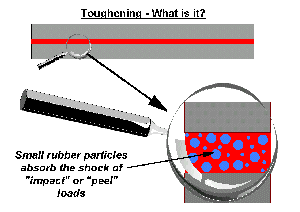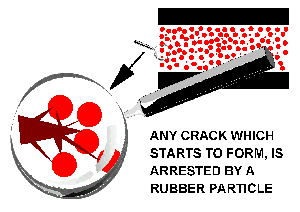

At the centre of any structural assembly is an adhesive, which is able to withstand stress caused by impact, vibration or peel loading.
Most adhesives tend to fall into two categories. They are either very flexible (like rubber and so whilst offering good impact resistance they produce equally flexible structures), or they are very rigid and brittle.
When it comes to producing strong, tough and rigid joints, only PERMABONDíS toughened adhesives are suitable.

By taking a rigid adhesive and then chemically introducing small rubber particles as the material cures, the finished product ends up as a combination of rigid matrix with a flexibilised, impact resisting core. In the event that a crack starts to "run" through the adhesive, it hits one of the rubber particles (typically about a micron in diameter) and is arrested. The energy at the tip of the crack is dissipated around the rubber - very similar to drilling out the tip of a crack in a casting. Although this crack may still propagate, it will need more energy to do so - it wonít just shatter as would more brittle products.
This process is essential for the formation of structural bonds, which can withstand high stress. It is these adhesives which hold together anti-tank weapons, truck doors, luxury coach structures, aeroplanes and now supersonic cars!
PERMABONDíS range of adhesives is wide and allows all manner of major applications to be tackled
If you need more help in selecting an adhesive for a particular application, please contact the
 |
 |
 |
||
| Sponsored by | This site best viewed with Microsoft Internet Explorer 3 | |||